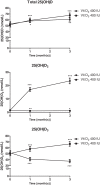Changes in circulating 25-hydroxyvitamin D according to vitamin D binding protein genotypes after vitamin D₃ or D₂supplementation
- PMID: 23556437
- PMCID: PMC3637219
- DOI: 10.1186/1475-2891-12-39
Changes in circulating 25-hydroxyvitamin D according to vitamin D binding protein genotypes after vitamin D₃ or D₂supplementation
Abstract
Background: It is not known whether genetic variation in the vitamin D binding protein (DBP) influences 25-hydroxyvitamin D levels [25(OH)D] after vitamin D supplementation. We aimed to investigate the changes of total 25(OH)D, 25(OH)D₃ and 25(OH)D₂ in a Thai cohort, according to type of vitamin D supplement (vitamin D₃ or D₂) and DBP genotype, after receiving vitamin D₃ or D₂ for 3 months.
Methods: Thirty-nine healthy subjects completed the study. All subjects received 400 IU of either vitamin D₃ or D₂, plus a calcium supplement, every day for 3 months. Total serum 25(OH)D, 25(OH)D₃ and 25(OH)D₂ were measured by LC-MS/MS. Individual genotyping of rs4588 in the DBP gene was performed using real-time PCR.
Results: Vitamin D₃ supplementation of 400 IU/d increased 25(OH)D₃ significantly (+16.2 ± 4.2 nmol/L, p <0.001). Vitamin D₂ (400 IU/d) caused increased 25(OH)D₂ levels (+22.0 ± 2.11 nmol/L, p <0.001), together with a decrease of 25(OH)D₃ (-14.2 ± 2.0 nmol/L, p <0.001). At 3 month, subjects in vitamin D3 group tended to have higher total 25(OH)D levels than those in vitamin D₂ (67.8 ± 3.9 vs. 61.0 ± 3.0 nmol/L; p = 0.08). Subjects were then classified into two subgroups: homozygous for the DBP rs4588 C allele (CC), and the rest (CA or AA). With D₃ supplementation, subjects with CA or AA alleles had significantly less increase in 25(OH)D₃ and total 25(OH)D when compared with those with the CC allele. However, no difference was found when the supplement was vitamin D₂.
Conclusion: Genetic variation in DBP (rs4588 SNP) influences responsiveness to vitamin D₃ but not vitamin D₂.
Figures
Similar articles
-
Associations of vitamin D binding protein variants with the vitamin D-induced increase in serum 25-hydroxyvitamin D.Clin Nutr ESPEN. 2019 Feb;29:59-64. doi: 10.1016/j.clnesp.2018.12.005. Epub 2018 Dec 28. Clin Nutr ESPEN. 2019. PMID: 30661702 Clinical Trial.
-
Efficacy of vitamin D supplementation according to vitamin D-binding protein polymorphisms.Nutrition. 2019 Jul-Aug;63-64:148-154. doi: 10.1016/j.nut.2019.02.003. Epub 2019 Feb 19. Nutrition. 2019. PMID: 30959383
-
Serum vitamin D metabolites in colorectal cancer patients receiving cholecalciferol supplementation: correlation with polymorphisms in the vitamin D genes.Horm Cancer. 2013 Aug;4(4):242-50. doi: 10.1007/s12672-013-0139-9. Epub 2013 Feb 28. Horm Cancer. 2013. PMID: 23456391 Free PMC article.
-
VITAMIN D BINDING PROTEIN AND 25-HYDROXYVITAMIN D LEVELS: EMERGING CLINICAL APPLICATIONS.Endocr Pract. 2017 May;23(5):605-613. doi: 10.4158/EP161604.RA. Epub 2017 Jan 17. Endocr Pract. 2017. PMID: 28095044 Free PMC article. Review.
-
Vitamin D Binding Protein (VDBP) and Its Gene Polymorphisms-The Risk of Malignant Tumors and Other Diseases.Int J Mol Sci. 2020 Oct 22;21(21):7822. doi: 10.3390/ijms21217822. Int J Mol Sci. 2020. PMID: 33105665 Free PMC article. Review.
Cited by
-
Comparison of the Effect of Daily Vitamin D2 and Vitamin D3 Supplementation on Serum 25-Hydroxyvitamin D Concentration (Total 25(OH)D, 25(OH)D2, and 25(OH)D3) and Importance of Body Mass Index: A Systematic Review and Meta-Analysis.Adv Nutr. 2024 Jan;15(1):100133. doi: 10.1016/j.advnut.2023.09.016. Epub 2023 Oct 20. Adv Nutr. 2024. PMID: 37865222 Free PMC article.
-
Factors Affecting 25-Hydroxyvitamin D Concentration in Response to Vitamin D Supplementation.Nutrients. 2015 Jun 25;7(7):5111-42. doi: 10.3390/nu7075111. Nutrients. 2015. PMID: 26121531 Free PMC article. Review.
-
Vitamin D3 seems more appropriate than D2 to sustain adequate levels of 25OHD: a pharmacokinetic approach.Eur J Clin Nutr. 2015 Jun;69(6):697-702. doi: 10.1038/ejcn.2015.16. Epub 2015 Mar 18. Eur J Clin Nutr. 2015. PMID: 25782422 Clinical Trial.
-
Vitamin D-binding protein levels do not influence the effect of vitamin D repletion on serum PTH and calcium: data from a randomized, controlled trial.J Clin Endocrinol Metab. 2014 Jul;99(7):2494-9. doi: 10.1210/jc.2014-1181. Epub 2014 Apr 8. J Clin Endocrinol Metab. 2014. PMID: 24712573 Free PMC article. Clinical Trial.
-
Determinants and Effects of Vitamin D Supplementation in Postmenopausal Women: A Systematic Review.Nutrients. 2023 Jan 29;15(3):685. doi: 10.3390/nu15030685. Nutrients. 2023. PMID: 36771392 Free PMC article.
References
-
- Institute of Medicine. Dietary Reference Intakes for Calcium and Vitamin D. Washington, DC: National Academy of Sciences; 2011.
-
- Holick MF, Binkley NC, Bischoff-Ferrari HA, Gordon CM, Hanley DA, Heaney RP, Murad MH, Weaver CM. Evaluation, treatment, and prevention of vitamin D deficiency: an Endocrine Society clinical practice guideline. J Clin Endocrinol Metab. pp. 1911–1930. - PubMed
-
- Lauridsen AL, Vestergaard P, Hermann AP, Brot C, Heickendorff L, Mosekilde L, Nexo E. Plasma concentrations of 25-hydroxy-vitamin D and 1,25-dihydroxy-vitamin D are related to the phenotype of Gc (vitamin D-binding protein): a cross-sectional study on 595 early postmenopausal women. Calcif Tissue Int. 2005;77(1):15–22. doi: 10.1007/s00223-004-0227-5. - DOI - PubMed
Publication types
MeSH terms
Substances
LinkOut - more resources
Full Text Sources
Other Literature Sources
Medical



